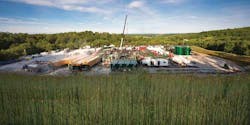New York Marcellus development still faces hurdles
ALBANY, NY—Marcellus Shale production reached 7 bcfd, surpassing the Haynesville to become the largest gas producing play in the US, according to a recent report from IHS. Gas production is largely derived from activity in Pennsylvania and West Virginia with no production from New York.
Recent pipeline expansions have helped this growth and increase in activity. In April, Pennsylvania Gov. Tom Corbett reported that the Marcellus Shale Impact Fee for natural gas drilling, part of Act 13 signed into law in Feb. 2012, has supplied more than $400 million to the state's revenue in the past 2 years. According to Corbett, the law is bringing Pennsylvania forward both economically and environmentally.
In New York, production continues to stall under the current moratorium. The state is now 4 years into the debate on whether hydraulic fracturing should be allowed. "The timing is speculative at this point," said Wayne D'Angelo, analyst, Kelley Drye & Warren. "The administration has changed its justification for extending the moratorium several times. It is impossible to guess where the goalpost will be moved next"
At the time of this writing, New York's State Health Commissioner Dr. Nirav Shah was continuing deliberations on health concerns related to hydraulic fracturing, while Gov. Andrew Cuomo awaited his recommendations. The final version of Shah's Health Impact Assessment had not been filed.
This Marcellus well in southwest Pennsylvania is one of many that helped the state generate $400 million in revenue as part of its new Impact Fee that was signed into law in Feb. 2012. Photo from FTS International.
The debate centered on a draft environmental impact statement (EIS) from New York's Department of Environmental Conservation (DEC). The EIS, which will be based in part on Dr. Shah's assessment, is a prerequisite to issuing permits for high-volume hydraulic fracturing. Meanwhile, the protracted EIS process has dragged on and proposed regulations governing how hydraulic fracturing must be conducted have lapsed. "New York has statutory requirements to finalize rules within 90 days, but EIS delays have forced them to repropose the regulations to restart the clock," D'Angelo said. "Even with the 3-month extension gained through DEC's previous reproposal, the 90-day clock has run out once again and, this time, the DEC has let the regulations lapse. Those lapsed regulations, if reproposed, would in fact be among the strongest state hydraulic fracturing regulations in the US."
The lapsed regulations included major carve-outs where hydraulic fracturing is not allowed. The prospective development area for Marcellus production is located in the heart of the primary watershed for the lower east portion of the state including New York City and Syracuse. New York's resistance is primarily driven by groundwater protection for the 18 primary aquifers located in its Southern tier.
The lapsed rules provided individual setbacks for surface drinking water, water sheds, flood plains, wells lakes, and man-made impoundments. Aggressive chemical disclosure, higher bond requirements, in-depth record keeping, and extensive water management plan stipulations would place New York as one of the more stringent areas to operate in the US should the state decide to lift its moratorium.
While New York can begin issuing high-volume hydraulic fracturing permits quickly after the EIS is finalized—and without re-proposing and finalizing hydraulic fracturing regulations—it is unclear whether the governor would allow such issuance or whether the EIS will be finalized any time soon.
The final decision will be Cuomo's, and there are indications that the hydraulic fracturing debate might follow a political timeline. "Reading between the lines suggests that politics are playing a significant role in this debate," said Kenneth Kamlet, special counsel, Hinman, Howard, & Kattell. In New York, there have been numerous action dates concerning hydraulic fracturing. "Each has come and gone with no action," Kamlet said. Cuomo has been careful not to promise results by a given date. As of this writing, Dr. Shah has stated that his report will be prepared in "several weeks." The question for most New Yorkers is if several weeks equates to 4 weeks, 10 weeks, or more. One editorial appearing in the New York Post referred to the fracturing issue as a "lose-lose" proposition for the governor, with the author suggesting that a final decision may be held off until after reelection; this has been denied by the administration.
While New York waits
The debate hinges on the environment and the economy. According to the New York State Department of Labor, the unemployment rate was 8.4% as of Feb. 2013. Technically, an influx of oil and gas activity would add jobs in the region as it has in states like North Dakota and Pennsylvania. Cuomo has stated publicly that the decision to allow hydraulic fracturing in New York would be based on science rather than economics.
For operators and service companies, the waiting game is difficult to play. According to Jim Smith, a spokesman with the Independent Oil and Gas Association of New York, "Companies are losing interest in the region." With the moratorium applied only to high-volume fracturing, drilling continues in the state, although it has decreased significantly. In 2008, New York issued 600 drilling permits and only 163 in 2012. Lower gas prices certainly have played a role in lowering activity levels, but the lack of a clear regulatory framework is encouraging companies to pursue opportunities elsewhere. "Operators want regulatory assurances—they want to know what the rules are," Smith said.
With no clear ruling in place, many local communities are now imposing bans on drilling activity by restructuring zoning laws. New York provides municipalities with home-rule authority, which local governments are using to enact restrictions against oil and gas activity. Two well-known cases, Dryden and Middlefield, have been upheld in the lower courts and are currently before New York's appellate court.
The lower court decisions confirm that municipalities are within their rights in using zoning powers to ban gas drilling. The appeal cases argue that the New York State Oil, Gas, and Solution Mining Law expressly "supersedes all local laws or ordinances relating to the regulation of the oil, gas, and solution mining industries." Two exceptions for this rule are applied to road use and taxation.
Pending the outcome of the current appeals, New York could evolve into a patchwork of regulatory environments where companies are forced to contend with general rules supplied by the state and individually with various local municipalities should the appellate court uphold home-rule authority.
From a local community perspective, using municipal authority to prevent industrial activity is understandable, according to D'Angelo. "But from an operational perspective, it becomes difficult to attract meaningful investment to the state," he added.
In addition, working within a number of regulatory loopholes can detract from safety. "It's important to pool expertise into one set of regulations," he said. By splintering regulatory environments, operating in New York could be burdensome, with no cohesive way to articulate the state's oil and gas policy.
"Ultimately, I think New York will allow hydraulic fracturing. There's too much economic upside," D'Angelo said. "There are environmental issues, but they can be managed and they have been successfully managed."

